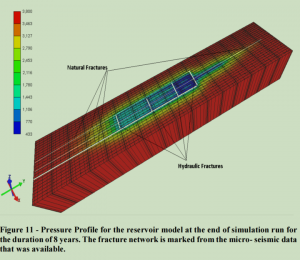MODELLING SHALE GAS FLOW USING THE IDEA OF APPARENT DYNAMIC PERMEABILITY
本研究的基本思想是提出一种工作流程,用于在数值模拟器中模拟气体流动,该流程将考虑页岩基质中存在的多孔隙系统的复杂性以及其中涉及的不同流动动力学。这里使用了由有机部分(干酪根)、无机物质以及天然和水力裂缝组成的多孔隙系统的概念。干酪根由于其高度多孔的性质、吸附气体的能力以及表面丰富的纳米孔而与其他页岩组分截然不同。尽管在微观尺度上提出了一些理论,但在处理油藏尺度模型时,微观模型中描述的孔隙系统的细节会丢失。为了克服这个问题,使用了动态表观渗透率的概念,它是基质压力的函数。这有助于将微观尺度模型的特定细节放大到油藏尺度,并有助于模拟基质和裂缝之间的达西流动、菲克扩散和过渡流动。
CMG软件的应用情况
在本研究中,使用了CMG-IMEX和CMG-STARS软件进行油藏模拟。这些软件能够处理多组分化学品,并且可以指定反应速率和化学计量数来描述凝胶化过程。通过调整岩石压缩性表,可以将微观尺度模型的假设放大到油藏尺度,并使用表观动态渗透率的概念来模拟基质和裂缝之间的不同流动机制。研究结果表明,扩散在低渗透基质中起着主导作用,并且当与解吸结合时,可以增加约30%的累计气体产量。

Abstract
The basic idea behind this research is to propose a work flow to model gas flow in numerical simulators, which would take into consideration all the complexities of the multiple porosity systems that exist in shale matrix and the different dynamics of flow involved within them. The concept of a multi porosity system that is composed of the organic part (kerogen), inorganic matter, and natural and hydraulic fractures is used here. Kerogen is very different from other shale components because of its highly porous nature, capability to adsorb gas and abundance of nano-pores on its surface.
Some theories have been put forward for the physics involved in shale on a micro scale level. However, when working with reservoir scale models, the details as described for porosity systems in micro scale models is lost. To overcome this problem, the idea of dynamic apparent permeability, which is a function of matrix pressure, is used. It helps in up-scaling the particulars of the micro scale model to a reservoir one and aids in modelling Darcy flow, Fickian diffusion and transition flow in between the matrix and fractures.
Our assumptions are validated by working with the case of a horizontal well model, producing gas from the Barnett shale formation, that doesn’t take into consideration the relevant flow phenomenon. History matching the model after integrating diffusion and desorption reveals that considering these additional processes impacts the assumed SRV region, affecting its volume as well as its properties. This would be a critical factor in optimizing completion design, to lower down the well cost for same or ever greater production. Similarly, this can play a vital role in well spacing for effective field development.
We summarize our findings from production forecasts that matrix contribution towards production is under estimated when relevant assumptions for shale are not modelled. This signifies the importance of better understating the transport phenomenon occurring in shale, which would enable us to have a greater insight to scrutinize production data and later to predict changes in production as completion methods are changed. This means that a multi stage high density fracturing job might not optimize the well in terms of its value. Decreasing our expenditure on well completions, such that their design results in lower production rates at the initial time period along with lower decline rates, would enable us to produce these wells longer for the same recovery. This would enable us to push the production in future where oil and gas prices might be better。
作者单位
作者Syed Munib Ullah Farid向德克萨斯A&M大学研究生与专业研究办公室提交了这篇论文,作为部分满足石油工程硕士学位要求的工作。论文完成于2015年5月,导师为John E. Killough教授,委员会成员包括Maria A. Barrufet和Zoya Heidari,系主任为A. Daniel Hill。

